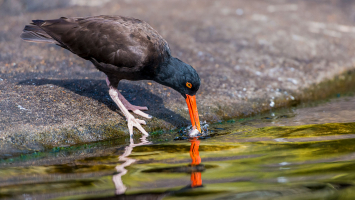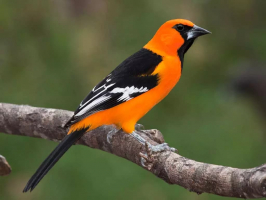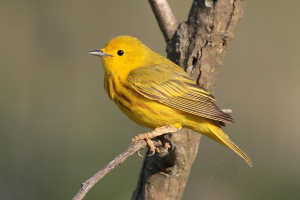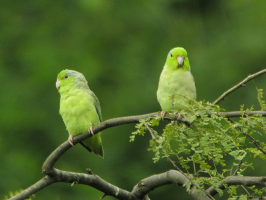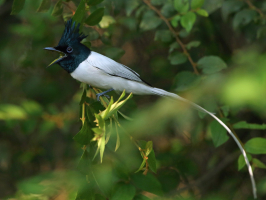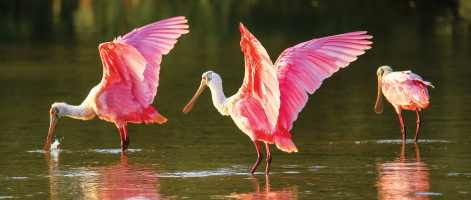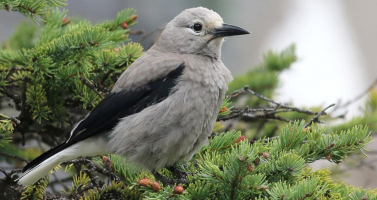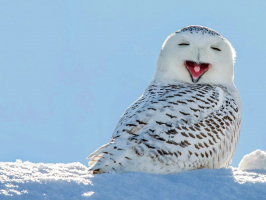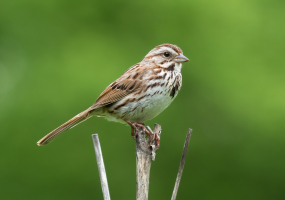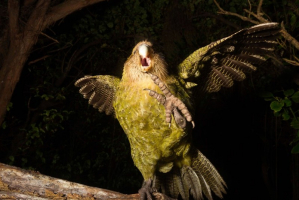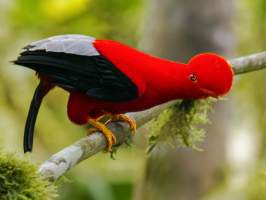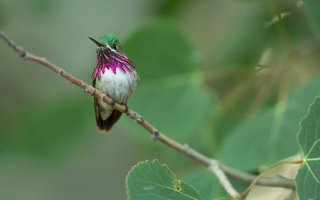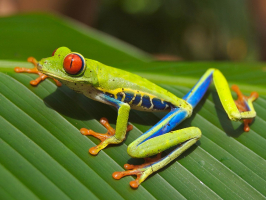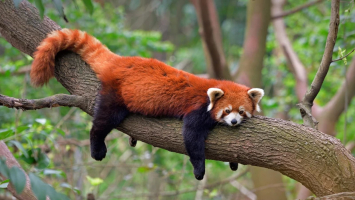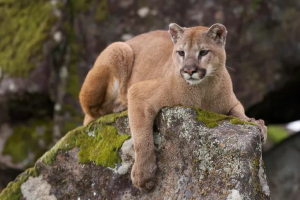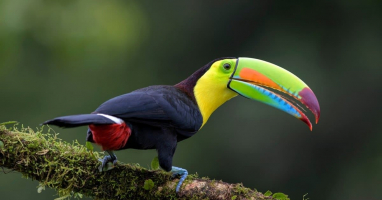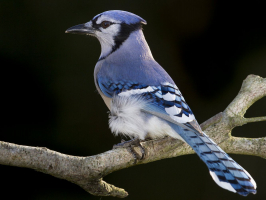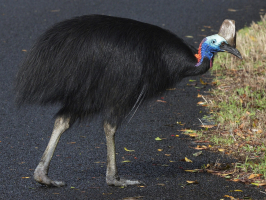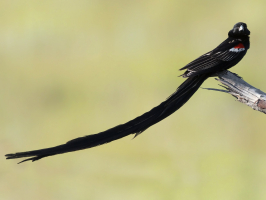Top 10 World's Beautiful Birds with Yellow Beaks
Beaks are one of the most remarkable parts of a bird’s body. A bright, attractive beak can add considerably to a bird’s appeal. In this case, it is yellow, it ... read more...will not be difficult for you to see a bird with a yellow beak in the garden or on the road. But which species is said to be the most beautiful with this brilliant yellow beak? Below is a list of the most beautiful birds with yellow beaks in the world, let's find out!
-
The Yellow-Legged Thrush (Turdus flavipes) is a songbird of northern and eastern South America and the Caribbean. It forages in shrubs and trees; it only seldom forages on the ground. It typically consumes fruits and berries, such as those from the Melastomataceae family. It hardly ever joins mixed-species feeding flocks since it prefers to stay on the treetops and finds it rarely advantageous to do so. On a bank or in between rocks, the nest is a lined shallow cup made of twigs. Reddish-blotched green or blue eggs with two or three are laid.
This thrush weighs 55–70 g and measures 22–23 cm in length. The eye-ring and legs of both sexes are yellow. The male has a yellow bill and is typically black in color with grey underparts and a slate-grey back. A male of one of the five subspecies, P. f. xanthoscelus of Tobago, is all-black, resembling the male Eurasian blackbird, but the color of the grey patches varies (Turdus merula). The bill of the female is dull, and she has paler underparts and warm brown upperparts. While the juvenile female resembles the adult female but is duller, flecked with orange above, and spotted and barred with dark brown below, the juvenile male is brownish with black wings and a tail.
eBird 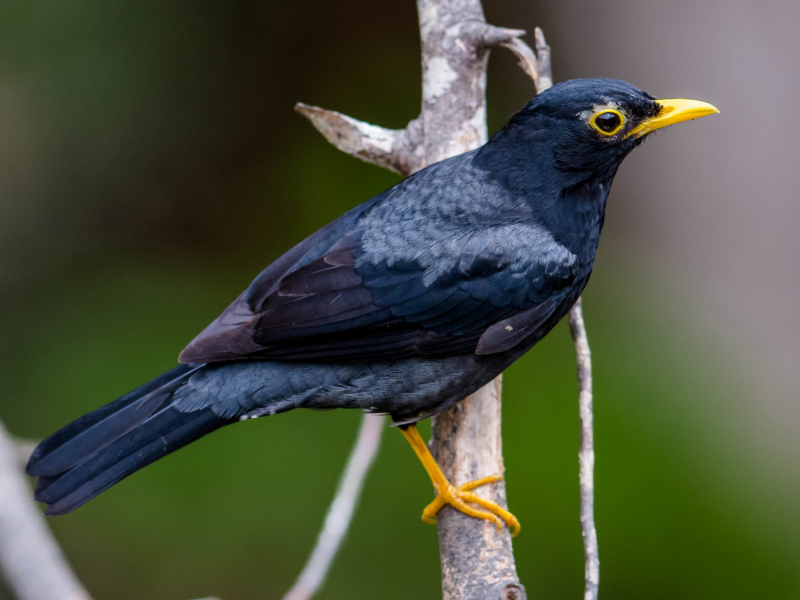
eBird -
The Common Blackbird (Turdus merula) is a species of true thrush. It is sometimes known as the Eurasian blackbird (particularly in North America, to differentiate it from the unrelated New World blackbirds), or just the blackbird in places where this does not cause confusion with a similarly-looking local species. It has been introduced to Australia and New Zealand and breeds in Europe, Asiatic Russia, and North Africa. Over the course of its extensive distribution, it has a number of subspecies; some of the Asian subspecies are occasionally regarded as whole species. The common blackbird can be resident, partially migratory, or entirely migratory depending on latitude.
The nominate subspecies of the common blackbird, Turdus merula merula, is distributed throughout most of Europe. The adult male has a rich, musical voice and is all black, with the exception of a yellow eye ring and beak. This species builds a tidy, cup-shaped nest that is tied together with mud to reproduce in gardens and woods. It consumes a variety of insects, earthworms, berries, and fruits since it is omnivorous.
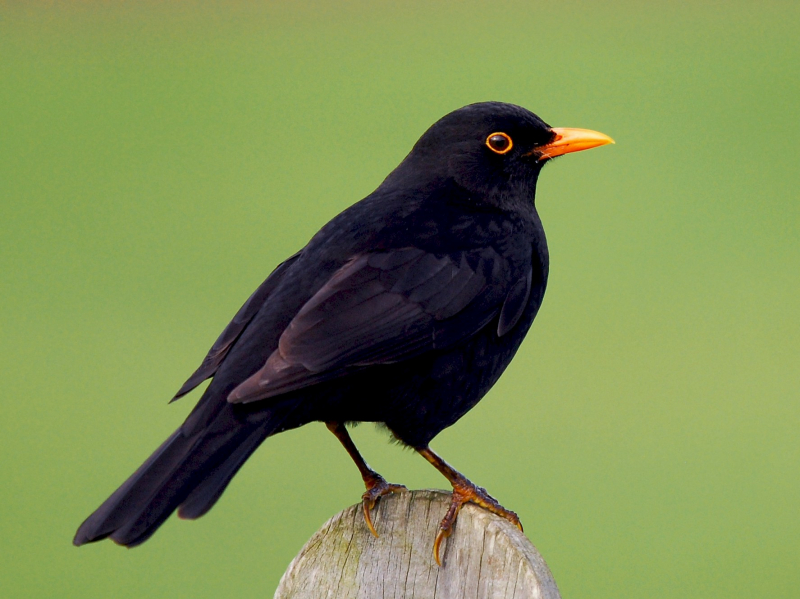
eBird 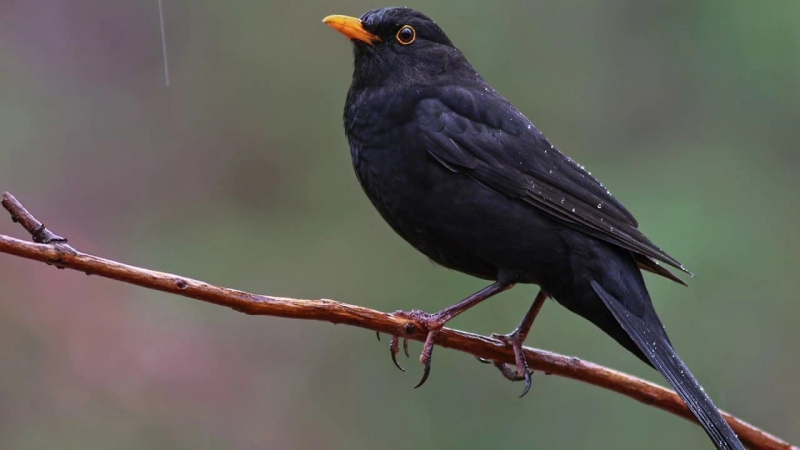
NatureRules1 Wiki - Fandom -
The Common Gull or sea mew (Larus canus) is a medium-sized gull that breeds in the Palearctic, northern Europe. The closely related short-billed gull is sometimes included in this species, which may be known collectively as "mew gull". Both common and short-billed gulls breed in large colonies close to water or in marshes, building-lined nests on the ground or in small trees. They are omnivores, like the majority of gulls, and will both scavenge and hunt small prey.
Common gulls are smaller than herring gulls and ring-billed gulls, measuring 40 to 46 cm in length as adults. It also differs from the ring-billed gull by having a shorter, more tapered bill that is unmarked during the breeding season and has a more greenish-yellow hue. The body is white below and grayish above. In the breeding season, the legs are yellow; in the winter, they become duller. In winter, the head is streaked grey and the bill often has a poorly defined blackish band near the tip, which is sometimes sufficiently obvious to cause confusion with the ring-billed gull. They have black wingtips with large white "mirrors" on the outer primaries p9 and p10, which are smaller than those in the short-billed gull.
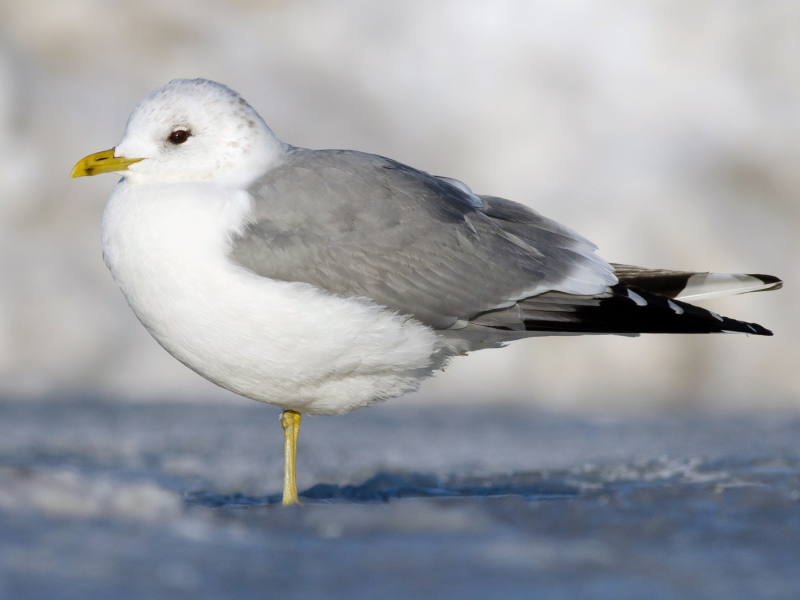
eBird 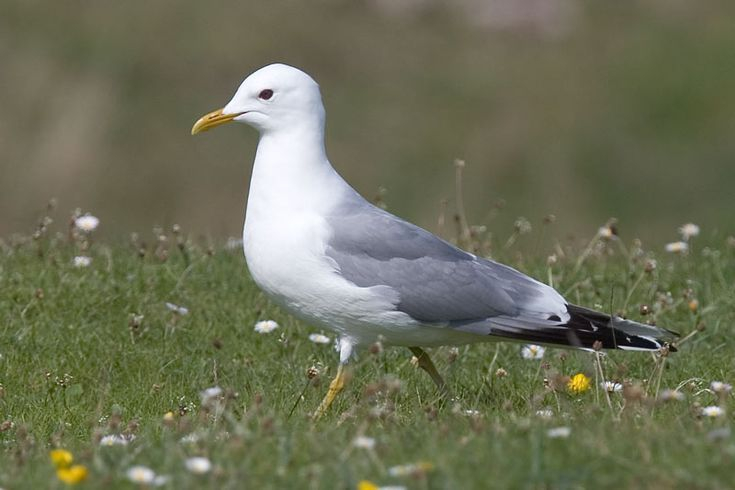
Pinterest -
The Bald Eagle is a classic icon of the United States, standing for strength, courage, and freedom. Chosen in 1782 as a symbol for our national emblem, today the bald eagle is depicted on a variety of official U.S. items, including passports, quarters, and the one-dollar bill. They are North American birds. Their range extends from the Mexico border through the United States and Canada. The birds are extremely populous in Alaska. They can be seen year-round in Alaska, along the East and West coasts, the Rocky Mountains, and the Mississippi River. The rest of the United States only sees bald eagles during the winter and their migration.
Bald eagles are huge, carnivorous raptors with a hooked yellow beak and brown body and wings. They also have a white head and tail. They have sharp black talons on the bottoms of their golden feet. Young bald eagles have a radically different appearance from adults; they are almost totally brown with sporadic white patterns on their chest and undersides of wings. The bill of the juvenile changes from a dark brownish-black to a yellow hue as it ages, and the head and tail become white. Bald eagles reach heights of 2.5 to 3 feet (0.7 to 0.9 meters), and their remarkable 6.5-foot wingspan (two meters). The size of female bald eagles is bigger than that of men, yet they are both the same hue.
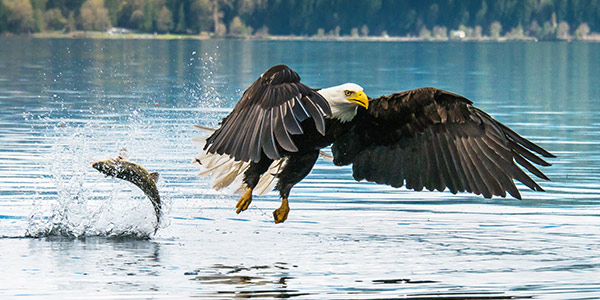
National Wildlife Federation 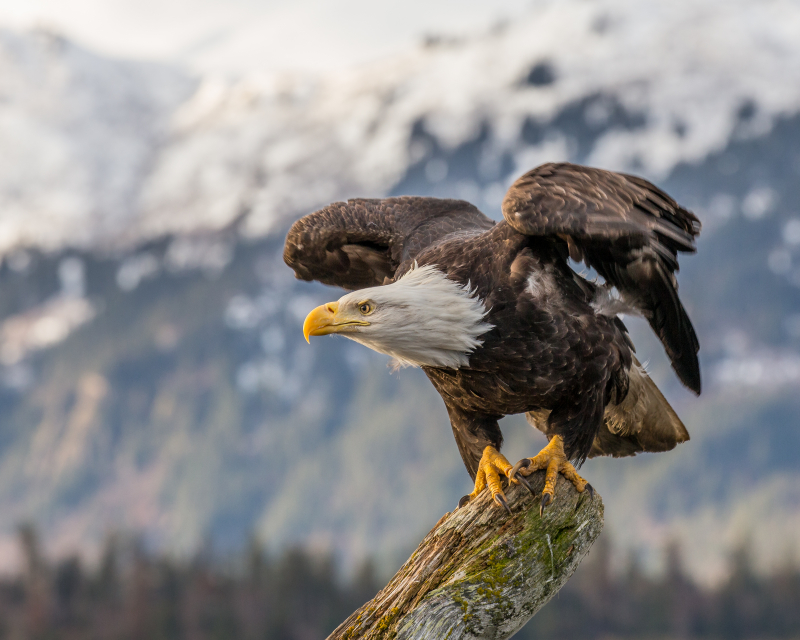
Wikipedia -
Steller's Sea Eagle (Haliaeetus pelagicus), also known as Pacific sea eagle or white-shouldered eagle, is a large diurnal bird of prey in the family Accipitridae. It is the most noticeable eagle and may be seen on rivers and sea shores in China, Russia, and Korea. Its stunning dark-colored body makes it simple to identify. In addition, it has a white forehead, a wedge-shaped tail, and a yellow beak. The lifespan of a Steller's sea eagle is 20 to 25 years, and it measures 85 to 105 cm long and weighs 5-9.5 kg. Steller's sea eagle females are bigger than males.
It is a carnivorous bird that eats crabs, carrion, gulls, small mammals, and fish or other aquatic life. It is also listed as one of the amazing black birds with yellow beaks. Steller's sea eagle is listed as vulnerable on the International Union for Conservation of Nature's Red List of threatened species.
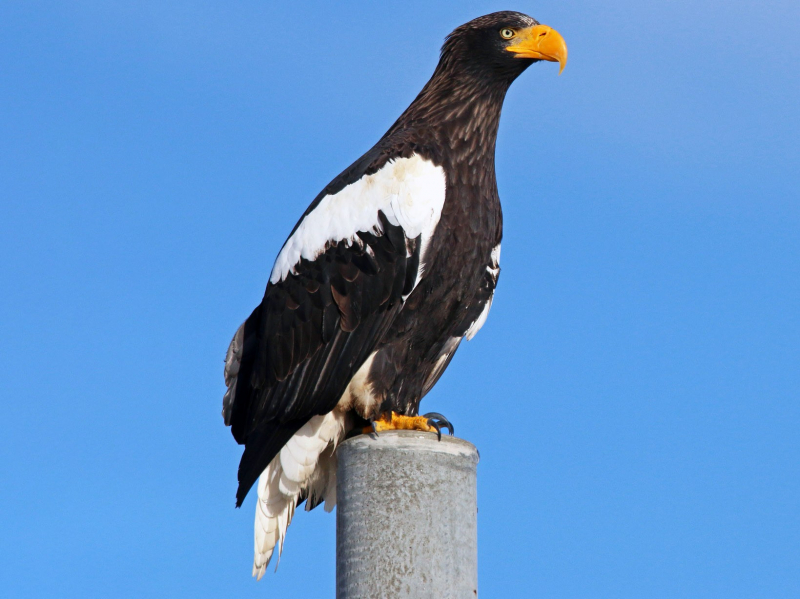
eBird 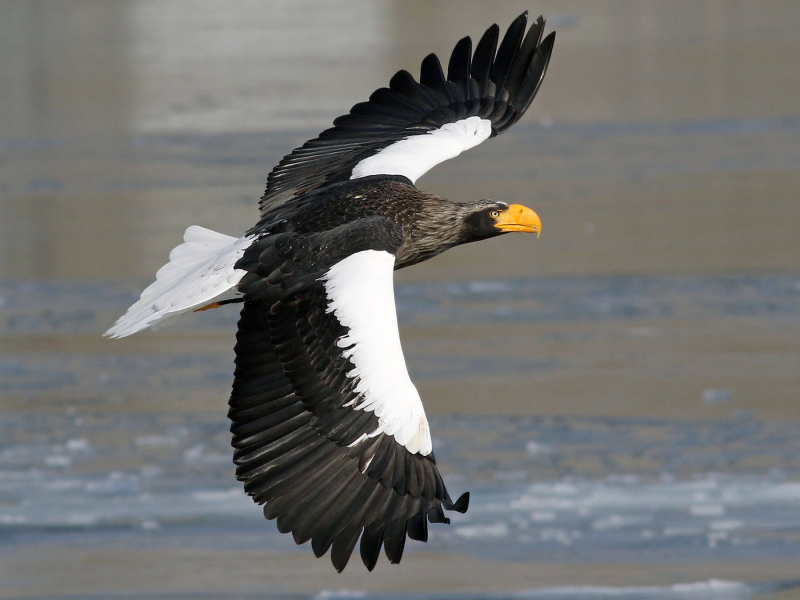
eBird -
The European Starling (Sturnus vulgaris), sometimes called the common starling or just the starling in Great Britain and Ireland is a medium-sized passerine bird that belongs to the Sturnidae family of starlings. It measures around 20 cm in length and has glossy, metallic-looking black plumage that is occasionally flecked with white. Young birds have browner plumage than adults do; their legs are pink, and their bills are black in the winter and yellow in the summer. It is a noisy bird with an unmusical but varied song, especially in communal roosts and other social settings. Its propensity for mimicking has been mentioned in works of literature such as the Mabinogion, Pliny the Elder, and William Shakespeare.
The large flocks that are characteristic of this species can help agriculture by reducing the number of invertebrate pests, but starlings can also be pests since they eat fruit and budding plants. Common starlings can be a bother because of the clutter and noise their sizable urban roosts produce. With the exception of avoiding the colonization of Western Australia, introduced populations have been subjected to a variety of measures, including culling.
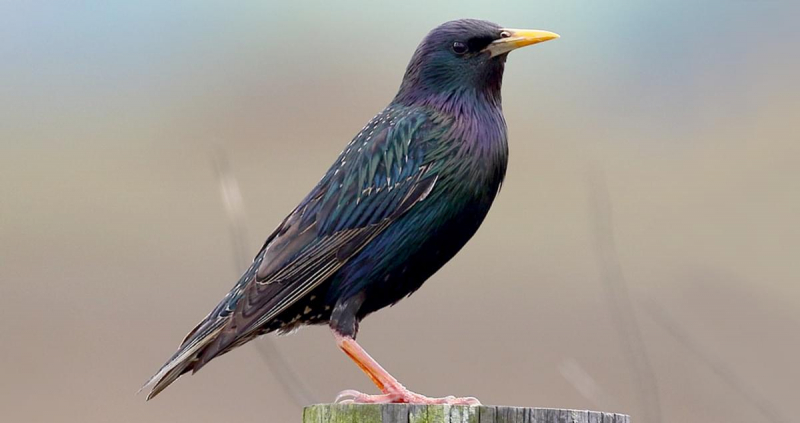
All About Birds 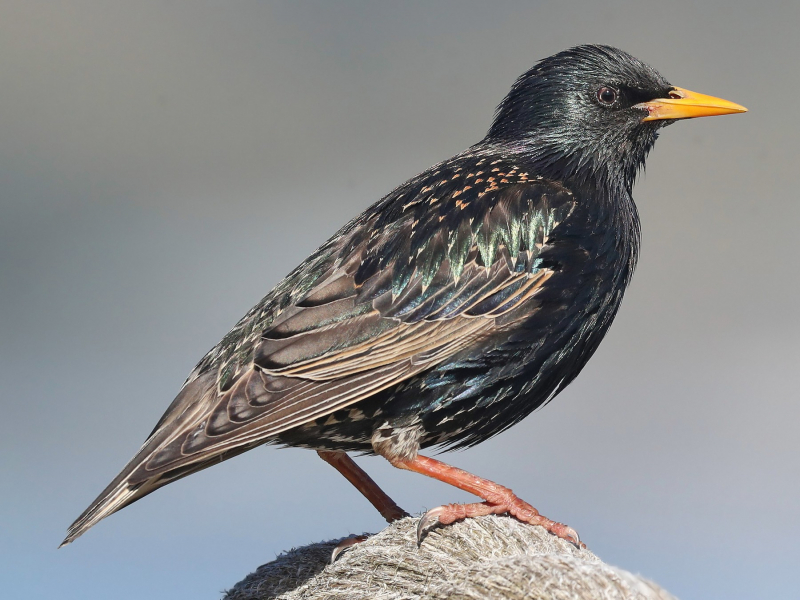
eBird -
The Cream-Colored Woodpecker (Celeus flavus) is popular for its distinct yellow plumage and beak along with dark brown wings and black tail. The male of the species can be identified by the female thanks to its strong, vivid red malar stripe. It weighs between 95 and 130 grams and can reach heights of 24 to 26 centimeters. The bird species is indigenous to South America, and it is most frequently observed in the countries of Colombia, Venezuela, and the Guianas, as well as in Peru, Bolivia, and the eastern part of Brazil.
Termites and arboreal ants make up the majority of the diet, with seeds and fruit serving as supplements. forages on trees as well as the ground, both alone and in groups. pecking at termite nests on trees, which is frequently observed. Although the cream-colored woodpecker is widely thought to be rare, it has been given the designation of Least Concern. Over the next few decades, it is anticipated that the population would decline due to the annual declines in suitable habitats.
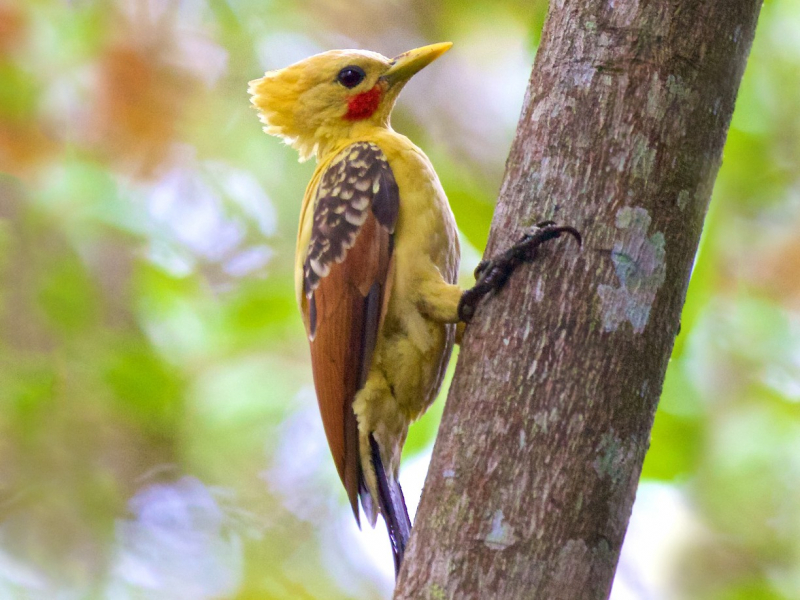
eBird 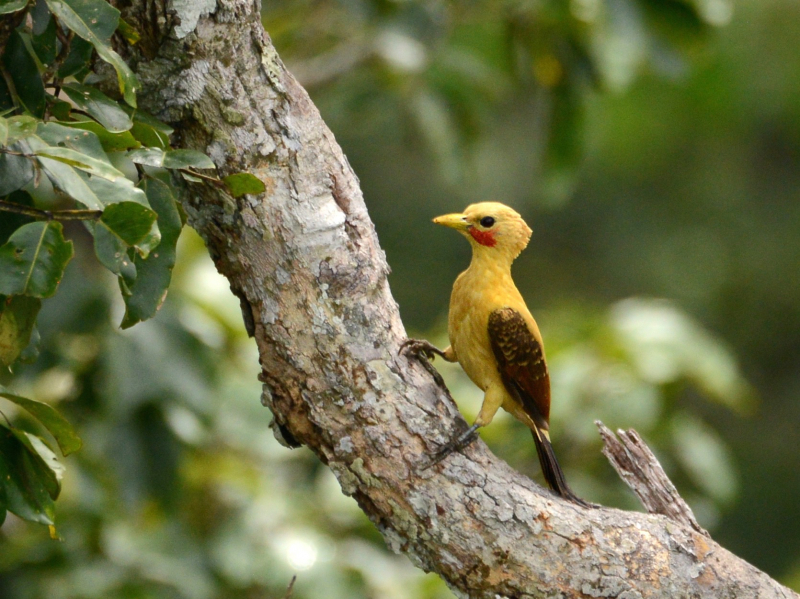
eBird -
The Javan Myna (Acridotheres javanicus), also known as the white-vented myna, is a species of myna. It is a member of the starling family. The Lesser Sundas, Sumatra, Singapore, Taiwan, Puerto Rico, Japan, and Nepal have all received introductions to the Javan myna, which is native to Bali and Java. The omnivorous Javan myna consumes human feces in addition to seeds, fruit, nectar, and insects.
Javan mynas are bold and not very afraid of humans. In Malaysia and Indonesia, Javan mynas are housed in cages. The birds forage in groups of at least two but commonly three or more, with all but one foraging and the other typically perched on a vantage point keeping watch. The majority of Javan mynas are black. The primaries have white bases, while the wings are brownish-black in color. White under tail coverts can be seen. On the forehead, there is a slight crest. It has yellow feet, legs, and a beak. Lemon-colored eyes are present. The immature is darker in color. It is 21–23 centimeters long. It is roughly 100 g in weight.
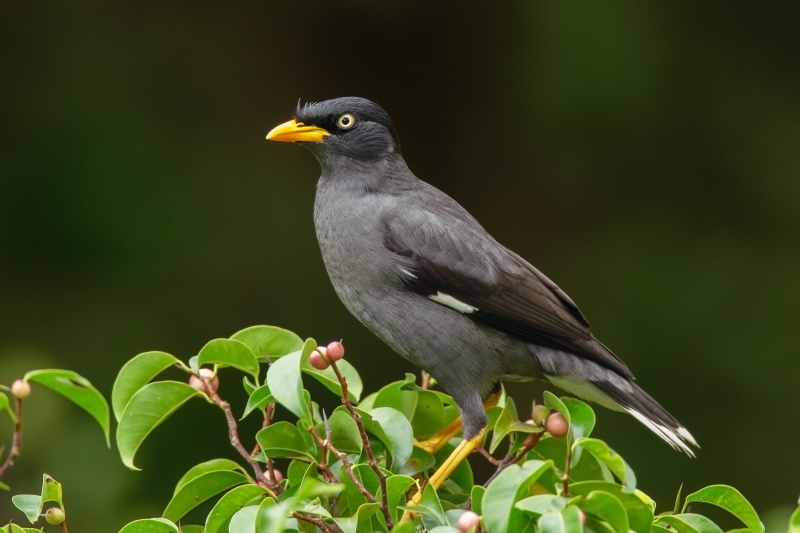
Wikipedia 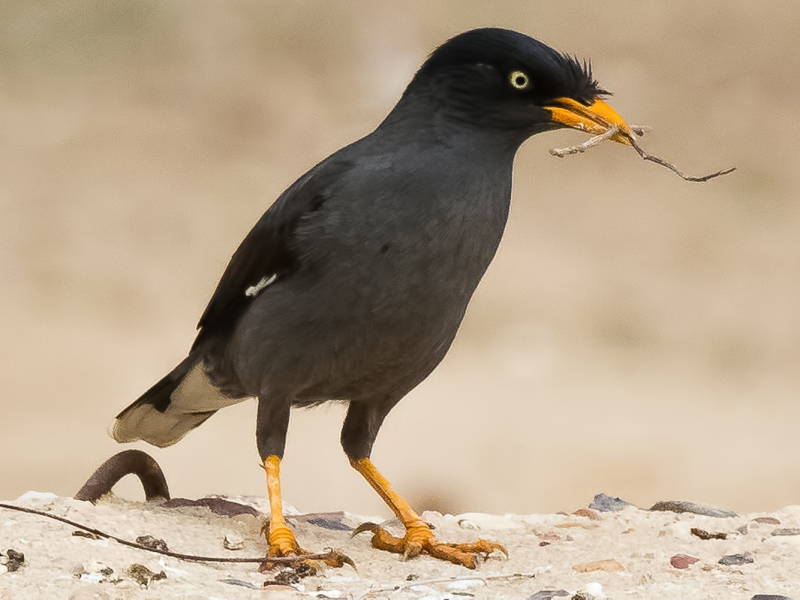
eBird -
The Alpine Chough or yellow-billed chough (Pyrrhocorax graculus) is a bird in the crow family, one of only two species in the genus Pyrrhocorax. Its two subspecies can breed at higher altitudes than any other bird because they breed in high mountains from Spain eastward through southern Europe and north Africa to Central Asia and Nepal. The eggs' adjustments to the thin air enhance oxygen uptake and lessen water loss.
The shiny black feathers, yellow beak, red legs, and unusual sounds of this bird all stand out. It flies buoyantly and acrobatically, its flight feathers spread out. The breeding site for Alpine choughs, which is typically a cave or crevice in a cliff face, is where they form lifelong relationships and show loyalty. It constructs a lined stick nest and lays three to five pale eggs with brown blotches. It forages on short-grazed grassland, frequently in flocks, mostly consuming invertebrate prey in the summer and fruit in the winter. It quickly approaches tourist attractions in search of more food.
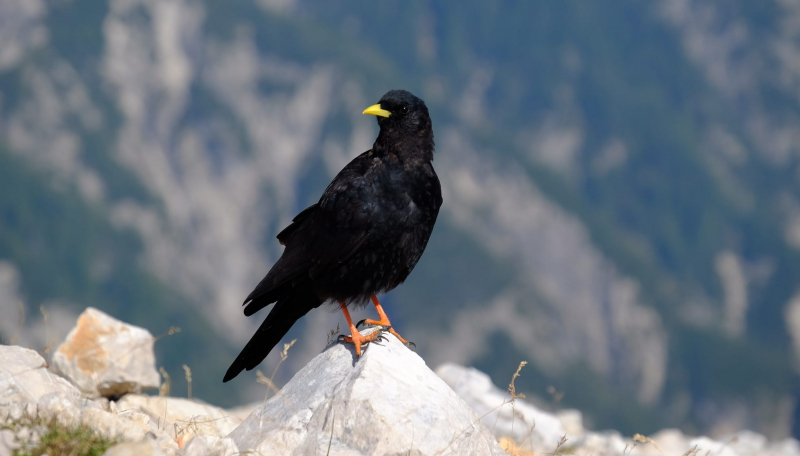
Kidadl 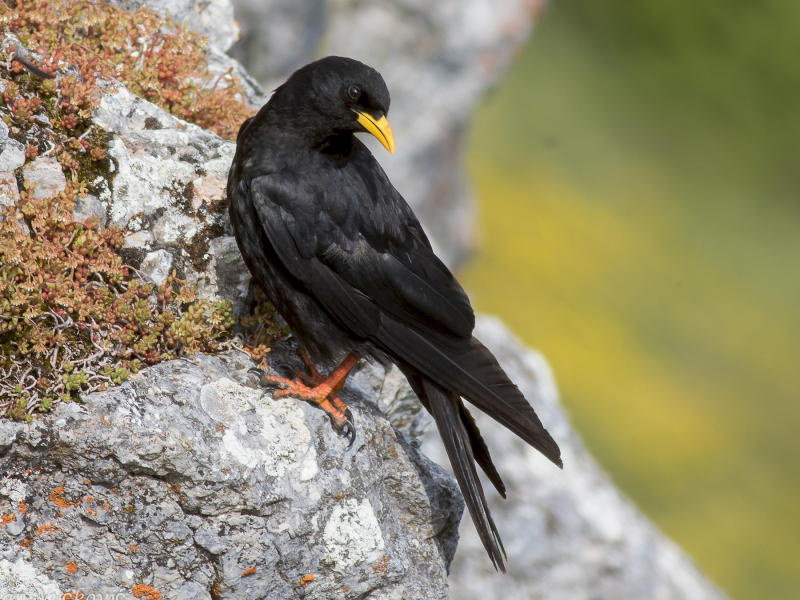
eBird -
The Golden-Headed Manakin (Ceratopipra erythrocephala) is a small passerine bird that breeds in tropical Central and South America in both wet and dry forests, secondary growth, and plantations. At breeding time, males are involved in a cooperative lekking behavior during which they jump, slide, and dart from perch to perch. This is a fairly common species with a wide range, and the International Union for Conservation of Nature has rated its conservation status as being of "least concern".
The golden-headed manakin, like other manakins, is a small, vividly colored forest bird that is typically 9.4 cm long and weighs 12.5 g. Aside from a golden hat, white and red thighs, pink legs, and a yellowish bill, the mature male is entirely black. Although smaller, shorter-tailed, and with pinkish (rather than brilliant orange) legs, the female and young males of this species are olive-green and resemble female white-bearded manakins. The golden-headed manakin has a number of different calls, including a buzzing pir pir prrrrrt, in addition to the buzzing display song.
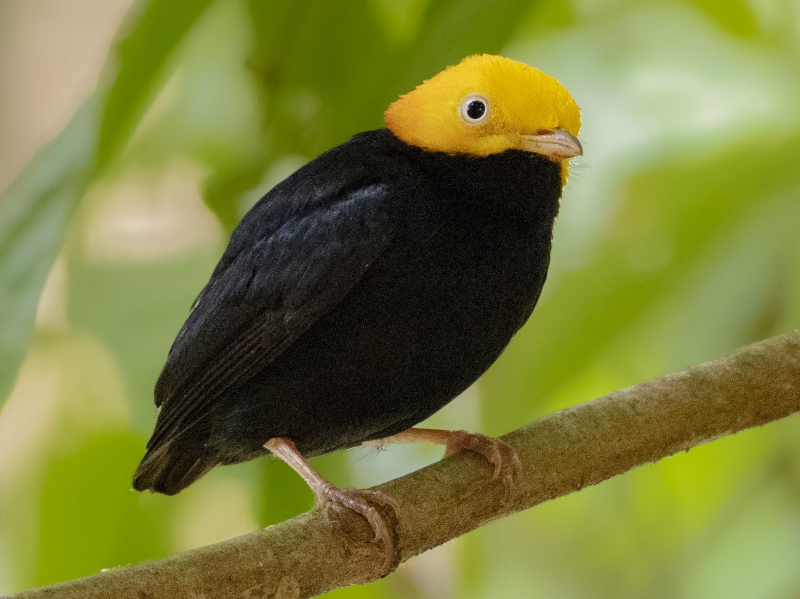
eBird 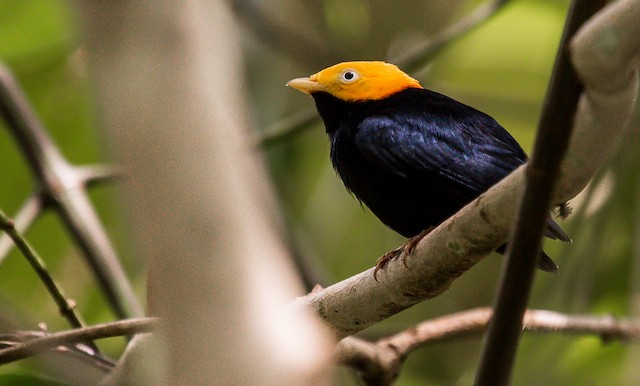
eBird












